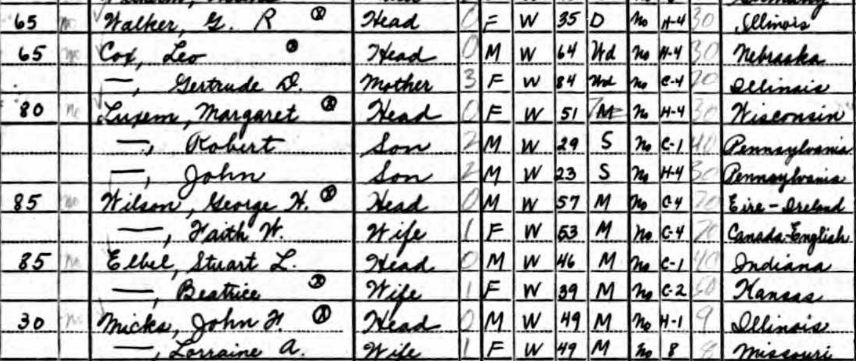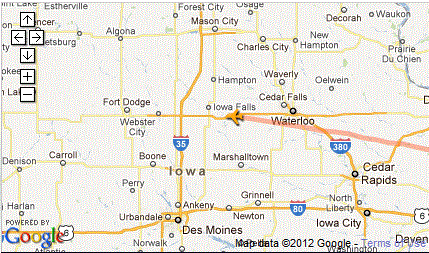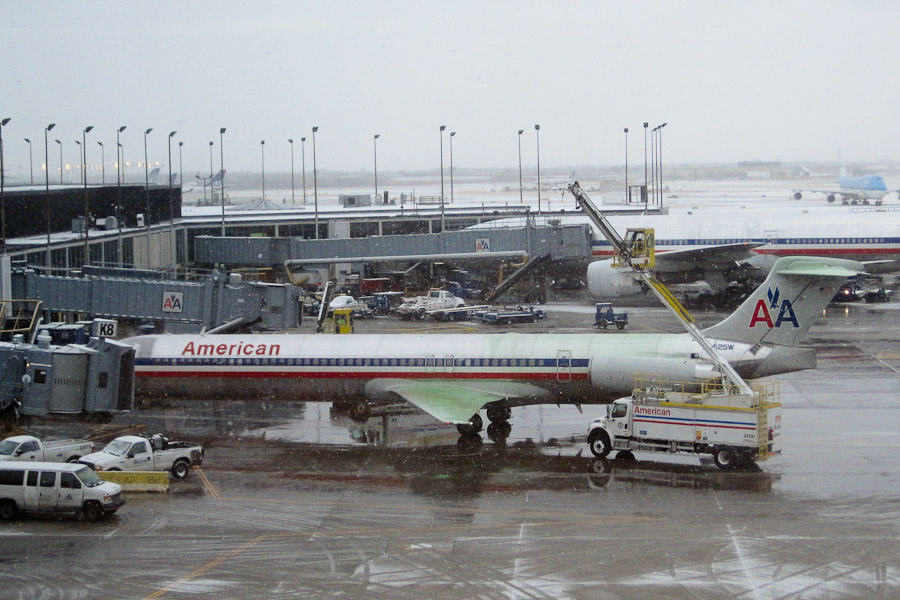Some items that have gotten my attention:
More, I'm sure, later.
I found out, after too many failed download attempts for no reason I could ascertain (come on, Amazon), the 1940 Census data is also available on Ancestry.com. Their servers actually served the data correctly. And so, I found this:

The apartment numbers aren't listed, and the building added an apartment to my entrance sometime in the last 70 years, but I think I can work it out. The first column shows the rent for each apartment. The three higher-rent apartments have to be the larger ones to the west. That means mine is either one of the two $65 apartments on the table or was vacant on 1 April 1940.
So the best I can do is that the three apartments on my side of the stairs that existed in 1940 contained a 35-year-old divorcée from Illinois who worked as an office manager in a brokerage, and a 64-year-old broker/solicitor from Nebraska who lived with his 84-year-old mother. My neighbors included a 51-year-old mother who lived with her 29- and 23-year-old sons, both of whom worked as wholesale salesmen; the 57-year-old treasurer of a wholesale varnish company and his 53-year-old wife; the 46-year-old head of the complaints department at Illinois Bell and his 39-year-old wife; and the building engineer and his wife, both of whom were 49.
All of these people were white, professional, and at least high-school educated. Six of eleven had college educations, a significantly higher proportion than the general public at the time. There were no children in the tier. All but two were U.S.-born. (The varnish-company treasurer came from the Republic of Ireland; his wife was English-Canadian.) All but the divorcée had lived in the same apartment for at least 5 years. Seven of eleven worked at least 40 hours during the previous week, including the poor janitor who worked 70. Salaries ranged from $600 (the 29-year-old son who sold furniture wholesale) to $5000+ (the Irish varnish company treasurer). Mrs. G.R. Walker, the most likely candidate for my predecessor in this apartment, made $2000, somewhat higher than the U.S. average salary in 1940 and approximately eqivalent to $32,000 today.
Today we're entirely professional (including three attorneys and two professional musicians), with a handful of young children, all of us college-educated or better. There is one foreign-born person; our average age, not counting the children, is about 38; and none of us worked 70 hours last week. Two of the seven apartments are rentals, the rest are owned. Adjusting for inflation, they cost almost exactly the same as in 1940.
In other words, the people who lived in my apartment building 70 years ago looked a lot like the people who live here today. And I wish I could meet them.
The Census and the National Archives have released the entire 1940 enumeration quasi-digitally. I think the data drop is great. I am going to download a few specific documents based on what I know about my own family, and about some of the places I've lived that were around in April 1940.
But as a software developer who works mainly with Cloud-based, large-data apps, I am puzzled by some of the National Archives' choices.
I say "quasi-digitally" because the National Archives didn't enter all the tabulated data per se; instead they scanned all the documents and put them out as massive JPEG images. I'm now downloading the data for one census tract, and the 29 MB ZIP file is taking forever to finish. The actual data I'm looking would take maybe 1-2 kB. That said, I understand it's a massive undertaking. There are hundreds of thousands of pages; obviously entering all the data would cost too much.
But this goes to the deeper problem: The Archives knew or should have known that they'd get millions of page views and thousands of download requests. So I need to ask, why did they make the following boneheaded technical decisions?
- They used classic ASP, an obsolete technology I haven't even used since 2001. The current Microsoft offering, ASP.NET MVC 3, is to classic ASP what a Boeing 787 is to a DC-3. It's an illuminated manuscript in the era of steam-driven presses.
- They organized the data by state and city, which makes sense, until you get to something the size of Chicago. Northfield Township, where I grew up, takes up one map and about 125 individual documents. Chicago has over 100 maps, which you have to navigate from map #1 to the end, and a ridiculous number of individual documents. You can search for the census tract you want by cross streets, but you can't search for the part of the city map you want by any visible means.
- I'm still waiting for my 32-page document after 22 minutes. Clearly the Archives don't have the bandwidth to handle this problem. Is this a budget issue? Perhaps Microsoft or Google could help here by donating some capacity until the rush is over?
In any event, once I get my documents, I'm going to spend some time going over them. I really want to find out what kind of people lived in my current apartment 70 years ago.
Update: The first download failed at 1.9 MB. The second attempt is at 6.6...and slowing down...
Update: The second and third attempts failed as well. I have, however, discovered that they've at least put the data out on Amazon Web Services. So...why are the downloads pooping out?
Via Sullivan, an awesome TV ad from The Guardian:
If you're driving in San Francisco, don't block the MUNI:
By early next year the city's entire fleet of 819 buses will be equipped with forward-facing cameras that take pictures of cars traveling or parked in the bus and transit-only lanes. A city employee then reviews the video to determine whether or not a violation has occurred — there are, of course, legitimate reasons a car might have to occupy a bus lane for a moment — and if so the fines range from $60 for moving vehicles to more than $100 for parked cars.
City officials consider the pilot program a success. "Schedule adherence" has improved, according to that update, as has general safety, since access to proper bus-stop curbs is impeded less often. In addition, the number of citations issued has risen over the past three years — from 1,311 in 2009 to 2,102 in 2010 and 3,052 last year, according to the San Francisco Chronicle.
At the root of the problem is a disconnect between the automobile and transit worldviews, transit planner Jarrett Walker explains in his excellent new book, Human Transit. (More on this in the coming days.) While an empty bus lane is actually a functional bus lane, an empty car lane is a wasted car lane, so drivers are quick to capitalize on what they view as a transportation inefficiency.
That's pretty cool. In principle, I approve of automated parking enforcement, such as Chicago's street sweeper cameras, even though I've had to pay fines as a result. Fair enforcement is all right with me. (But don't get me started on how Chicago puts up street-sweeping signs the day before...)
Earlier I mentioned how technology makes aviation easier. Now here's how it makes aviation cooler: For the first time in Daily Parker history, I'm writing about a flight in real time.
I am approximately here:

FlightAware adds the third dimension, putting me at FL360.
Of course, I have actual work to do, which is really why I bought Internet access for this flight. I still think this is incredibly cool.
(For the record, my flight didn't leave on time, but it did leave. At takeoff, O'Hare conditions were 1600 m visibility with 400 m indefinite ceiling, blowing snow, and 48 km/h wind gusts. Had my plane not gotten to O'Hare when it did, it might still be holding over Janesville. Also for the record, the picture above shows my location when I started this post; the little globe icon below right will show you where I was when I posted it.)
Via James Fallows, here is the FlightAware track (and the KML) for yesterday's Boeing 787 test flight:

That. Is. Cool.
I remember traveling in the 1970s and 1980s, when no one could reliably answer this question until the plane actually left the runway. But today I'm at O'Hare while snow is falling, and it looks like my flight will in fact take off on time despite the snow and the lengthening list of delayed flights on the arrivals board.
How do I know?
First stop is the American Airlines website. Their flight status tool says my plane departs on time from gate K5. And the page has a link to "arriving flight information," which tells me that the plane I'm on will land in 10 minutes.
Oh, really? Yes, really, as Flight Aware's real-time tracker shows me. At this moment, the airplane taking me to San Francisco is heading straight for the O'Hare VOR about 70 km away. (It's over Joliet—no, wait, now it's over Naperville!)
The airline has done it right. By providing real-time information, they're putting me at ease. Even if the incoming plane were circling over Springfield, that would still help me by letting me plan how long I can sit here working before I have to schlepp to the gate.

Update: In the time it took to write this entry, my plane has arrived, and I can see it taxiing towards me right now. I am not making this up. That's not my plane, by the way. That's a plane being de-iced, to show you why I might be a little on edge about my actual departure time today.
Via Microsoft guru Raymond Chen, news that tourists continually block traffic outside Abbey Road Studios:
Apparently the studio also has a webcam.
The famous zebra crossing is here.
New time-lapse video from the International Space Station: